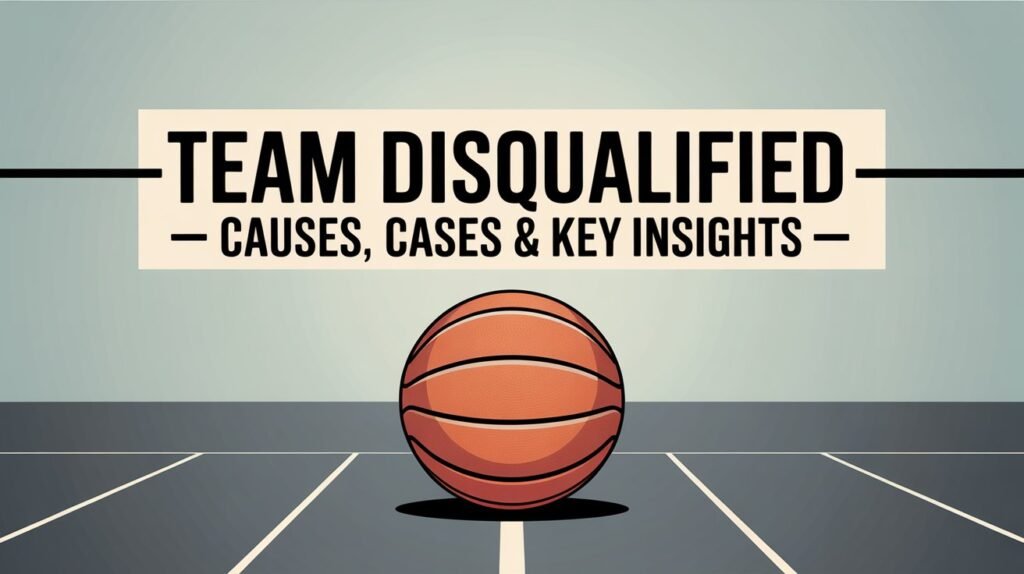Introduction
When we speak of a “team disquantified”, we’re referring to the unfortunate and often distressing scenario in which an entire team is removed from competition—be it a sporting event, tournament, or championship—due to a violation of rules, technical errors, or procedural missteps. While the term “disqualify” commonly applies to individuals, team-wide disqualification has surfaced in high-profile arenas from skiing to track relays and even school tournaments. This article explores the varied triggers behind team disqualification, illustrates real-world cases from recent years, and draws key insights and lessons to help prevent such outcomes in the future.
Common Causes of Team Disqualification
Equipment Irregularities and Regulation Violations
One of the most prominent causes of team disqualification in recent sports history involves breaches in equipment standards. For instance, in a major ski jumping event, several male athletes were disqualified for wearing suits that failed to meet updated regulatory requirements—like improper waist size—shortly after tighter enforcement followed a high-profile suit tampering scandal. Additionally, two Olympic ski jumpers, along with team officials, faced disqualification and ethics charges for using suits modified with reinforced thread—an act clearly outside Federation rules—leading to the stripping of medal standings.
Administrative Errors and Procedural Oversights
At times, technicalities and administrative details can cost a team their place. A poignant example comes from youth sports, where a Little League All-Star team was disqualified from a state tournament—despite playing valiantly—because they failed to meet the minimum required number of regular-season games, largely due to weather disruptions.
Conduct and Rule Infractions
Disqualification isn’t always about equipment or eligibility; it’s also about conduct. In a surprising case, a high school sprinter was stripped of a state championship title after she celebrated with a fire extinguisher on the track—emulating Olympic legends—but deemed unsportsmanlike by officials.
In golf, professional players were themselves disqualified for separate infractions. One signed the wrong scorecard, and another failed to hole out—both procedural missteps resulting in disqualification.
Unauthorized Messaging or Symbolism
In the realm of international performance, even political statements can lead to disqualification. At the Olympics, a refugee athlete was disqualified for wearing a cape with a slogan advocating for human rights, violating rules prohibiting political messaging in competition attire.
High‑Profile Cases in Focus
Ski Jumping Equipment Scandals
The ski jumping scandal stands out as a cautionary tale. Not only were athletes disqualified, but team officials were also implicated for deliberately altering suits, and medal placements were revoked. Despite denials from athletes about knowing the modifications, the fallout offers powerful insight into how equipment manipulation can destabilize sport integrity.
Youth Sports and Eligibility Rules
The Little League case—a youth team denied a chance to compete due to game-count rules—highlights how logistical challenges (like record weather) can translate into heartbreak if governing bodies remain inflexible.
Celebration Gone Wrong
The sprinter’s disqualification underscores how even post-competition behavior, if seen as unsportsmanlike or in violation of conduct norms, can nullify performance—even when the victory appears secure.
Professional Golf and Technical Mistakes
At a professional golf event, two players were disqualified not for poor play but for technical oversights—one mis-signed scorecard, another failing to hole out. These incidents show that in professional sport, even minor mistakes can produce dramatic consequences.
Political Expression and Rule Enforcement
The Olympic incident involving political messaging illustrates the fine line between self-expression and regulatory violation. Political slogans are strictly banned in many international arenas, and crossing that boundary can lead to immediate disqualification.
The Wider Impact of Team Disqualification
Emotional and Reputational Toll
The emotional effect on athletes can be devastating—especially for youth teams who may see their hard work vanish due to technicalities. In the case of the Little League team, coaches and players voiced heartbreak and regret.
Integrity and Trust in Competitions
When teams are disqualified, especially for perceived oversights or aggressive rule enforcement, it can erode trust among fans, athletes, and sports institutions. Equipment scandals, for instance, prompt scrutiny of both control processes and ethical oversight.
Public Perception and Rule Clarity
Public reaction to disqualification can be mixed. Supporters may rally behind athletes, advocating for reinstatement if the incident is viewed as harmless. Conversely, events like political expression often see strong enforcement, with limited public sympathy.
Key Insights & Prevention Strategies
Proactive Compliance Checks
Sports organizations must emphasize proactive compliance—especially when equipment regulations change rapidly. Rigorous pre-competition checks and clear communication with teams can avert situations like equipment-related disqualifications.
Flexible Governance with Compassion
Youth competitions should consider contextual flexibility. In cases where external circumstances hinder eligibility requirements, governing bodies might adapt rules or offer official waivers.
Conduct Training and Awareness
Teams should be briefed not only on competitive rules, but also codes of conduct and how celebrations can violate expectations—even when done in homage or good spirit.
Simplified Administrative Processes
Technical errors show the need for redundant checks—perhaps officials verifying scorecards and competition steps immediately to catch mistakes before they result in disqualification.
Clear Boundaries for Expression
Incidents involving political messaging demonstrate the importance of defining where personal expression crosses regulatory boundaries. Clear education for athletes on what’s permitted in attire and messaging is essential.
Conclusion
The concept of “team disquantified” encapsulates a wide range of real-world scenarios—from technical gear infractions and administrative mishaps to emotional missteps and political expression. Each case underscores the importance of clarity, fairness, and communication in sports governance. Whether it’s adjusting to evolving equipment rules, protecting young athletes from procedural pitfalls, or balancing self-expression with competition rules, the goal remains the same: uphold the spirit of sport with fairness and transparency. By learning from these varied examples—across ski jumping, youth league baseball, track celebrations, professional golf, and global competitions—we can work toward competition frameworks that are both just and resilient.
Want more to read? Visit dDooks.


